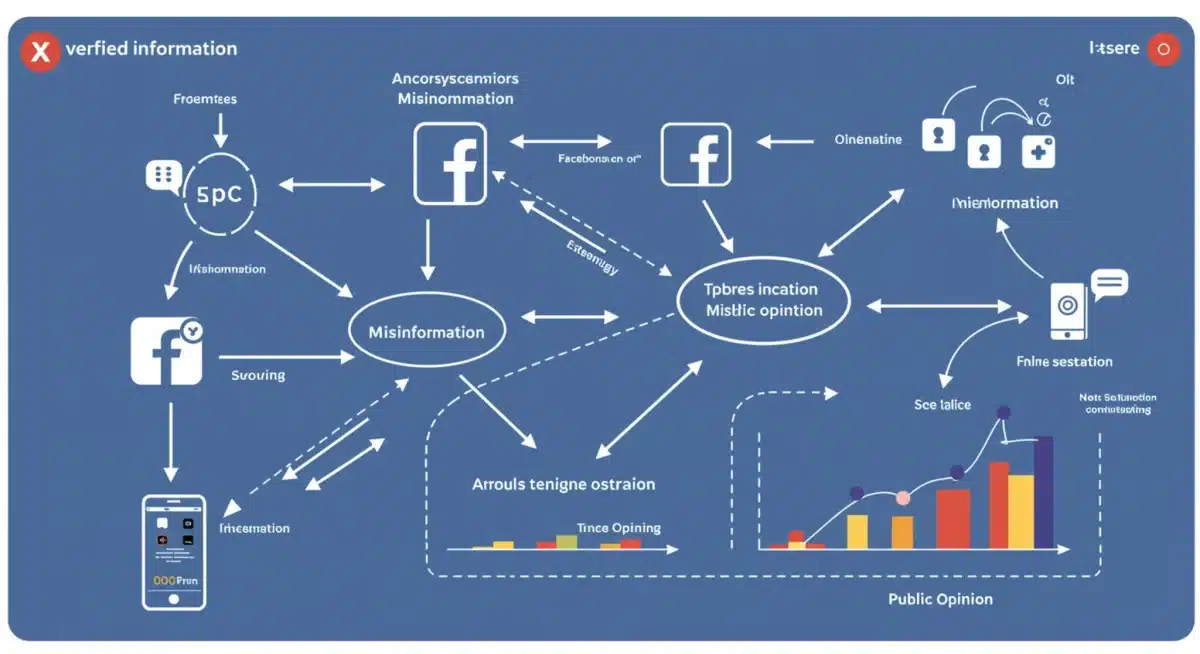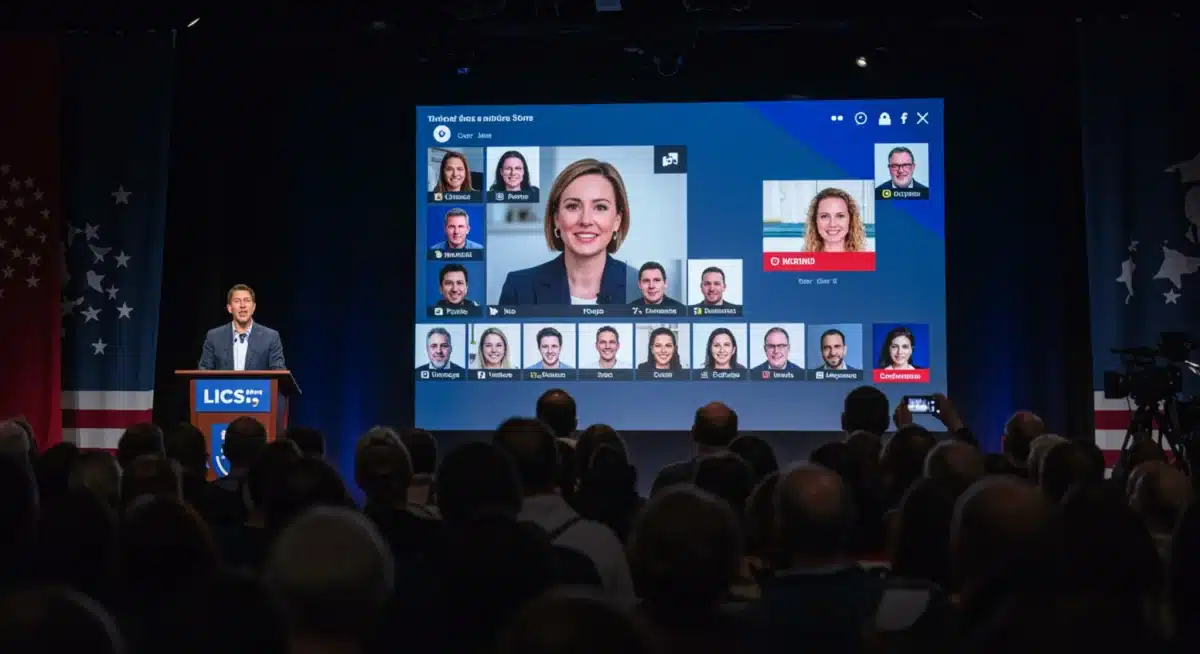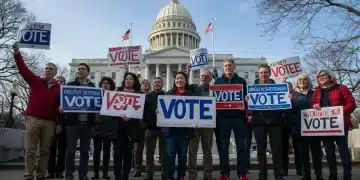Social Media’s Role in Shaping 2024 Election Opinion

Social media platforms are fundamentally reshaping public opinion during the 2024 Presidential Election by influencing political discourse, disseminating information, and mobilizing voters, creating both opportunities and challenges for democratic processes.
As the 2024 Presidential Election cycle intensifies, understanding the profound influence of social media becomes paramount. This article delves into Examining the Role of Social Media in Shaping Public Opinion During the 2024 Presidential Election, exploring how these digital platforms are not merely communication tools but active participants in the democratic process.
The Digital Battlefield: Social Media as a Primary News Source
In the contemporary political landscape, social media has transcended its initial role as a casual networking tool, evolving into a primary conduit for news and political information. For many Americans, particularly younger demographics, platforms like X (formerly Twitter), Facebook, Instagram, and TikTok are the first and often only places they encounter political developments and candidate statements. This shift has monumental implications for how public opinion is formed and influenced during the 2024 Presidential Election.
The immediacy and ubiquity of social media mean that news, whether verified or not, spreads at an unprecedented pace. Traditional gatekeepers of information, such as established news organizations, now compete with an endless stream of user-generated content, partisan outlets, and international actors. This decentralized information ecosystem presents both opportunities for diverse perspectives and significant challenges in discerning truth from falsehood.
The Rise of Algorithmic Influence
- Personalized Feeds: Algorithms curate content based on user engagement, inadvertently creating echo chambers.
- Reinforcement of Beliefs: Users are often shown content that aligns with their existing views, solidifying biases.
- Exposure to Extremes: Content designed for virality, often sensational or extreme, can gain disproportionate reach.
This algorithmic curation means that individuals are frequently exposed to a narrow band of information, reinforcing their pre-existing beliefs and potentially polarizing viewpoints. While this can foster community among like-minded individuals, it also reduces exposure to alternative perspectives, hindering nuanced political discourse. The challenge for voters is to actively seek out diverse sources and critically evaluate the information presented to them.
Ultimately, social media’s role as a primary news source in the 2024 election cycle is a double-edged sword. It offers unparalleled access to information and direct engagement with political figures, yet it also demands a higher degree of media literacy and critical thinking from its users to navigate the complex and often biased information flows effectively.
Campaign Strategies in the Social Media Age
The 2024 Presidential Election campaigns are meticulously crafted with social media at their core. Candidates and their teams recognize that digital platforms are indispensable for reaching voters, shaping narratives, and mobilizing support. This strategic embrace of social media has fundamentally altered traditional campaign playbooks, emphasizing direct communication and rapid response.
Campaigns leverage social media for a multitude of purposes, from announcing policy positions and responding to opponents’ statements in real-time to sharing behind-the-scenes glimpses that humanize candidates. The goal is not just to disseminate information but to foster a sense of connection and community among supporters, transforming passive viewers into active advocates.
Targeted Messaging and Micro-targeting
One of the most potent aspects of social media campaigning is the ability to micro-target specific demographics with tailored messages. Data analytics allow campaigns to identify voter segments based on their interests, demographics, and online behavior, delivering highly personalized content designed to resonate with their particular concerns. This level of precision was unimaginable in previous election cycles.
- Demographic Segmentation: Ads and content are customized for age groups, geographic locations, and socioeconomic statuses.
- Issue-Based Targeting: Messages focus on specific policy areas relevant to particular voter segments.
- Behavioral Retargeting: Users who interact with certain content may be shown related follow-up messages.
While micro-targeting can make campaigns more efficient, it also raises ethical questions about privacy and the potential for manipulative messaging. Voters may be exposed to different, sometimes conflicting, narratives depending on their online profile, making it challenging to form a holistic understanding of a candidate’s platform.
Furthermore, social media platforms enable rapid response to breaking news or opponents’ attacks. Campaign teams are constantly monitoring online conversations, ready to issue rebuttals, clarify positions, or amplify favorable narratives almost instantaneously. This real-time engagement keeps campaigns agile but also contributes to the fast-paced, often reactive nature of political discourse.
The Pervasiveness of Misinformation and Disinformation
Perhaps one of the most critical challenges in Examining the Role of Social Media in Shaping Public Opinion During the 2024 Presidential Election is the rampant spread of misinformation and disinformation. The open and decentralized nature of these platforms, while fostering free expression, also provides fertile ground for false or misleading content to proliferate, often with malicious intent.
Misinformation, which refers to incorrect information spread unintentionally, and disinformation, which is deliberately fabricated and spread to deceive, both pose significant threats to the integrity of the democratic process. They can sow doubt, erode trust in institutions, and manipulate voter perceptions, making it difficult for citizens to make informed decisions.
Tactics Used to Spread False Narratives
- Deepfakes and AI-Generated Content: Advanced technology creates highly realistic but fake images, audio, and video.
- Conspiracy Theories: Complex, unfounded narratives gain traction, often exploiting societal anxieties.
- Propaganda and State-Sponsored Actors: Foreign entities or partisan groups create and amplify divisive content.
The speed at which false narratives can spread on social media far outpaces the ability of fact-checkers and platforms to contain them. By the time a piece of misinformation is debunked, it may have already reached millions and influenced perceptions. This creates a significant challenge for voters, who must constantly be vigilant and critical of the information they consume.

Social media companies have implemented measures to combat misinformation, including content moderation, fact-checking partnerships, and warning labels. However, these efforts are often criticized as insufficient or inconsistent, highlighting the immense scale of the problem. The 2024 election will undoubtedly test the resilience of these systems and the public’s ability to navigate a complex information environment.
Echo Chambers and Polarization
Social media’s architecture inherently contributes to the formation of echo chambers and filter bubbles, exacerbating political polarization. As users primarily follow accounts and engage with content that aligns with their existing views, they become increasingly isolated from dissenting opinions. This phenomenon has profound implications for public opinion during the 2024 Presidential Election, hindering constructive dialogue and fostering division.
Within these echo chambers, individuals are constantly reinforced in their beliefs, often leading to more extreme stances. Exposure to a narrow range of perspectives can make it difficult to understand or empathize with those holding different political views, contributing to a sense of ‘us vs. them’ that undermines civil discourse and compromise.
Mechanisms of Echo Chamber Formation
- Algorithmic Amplification: Platforms prioritize content users are likely to engage with, often reinforcing existing biases.
- Homophilous Connections: Users tend to connect with others who share similar interests and beliefs.
- Selective Exposure: Individuals actively seek out information that confirms their worldview and avoid contradictory information.
The resulting polarization can have tangible effects on election outcomes. Voters within echo chambers may become less amenable to persuasion, more entrenched in their partisan identity, and less likely to engage in cross-partisan dialogue. This can lead to a more fractured electorate, where consensus on critical issues becomes increasingly elusive.
Addressing the challenges of echo chambers requires a multi-pronged approach, including promoting media literacy, encouraging platforms to diversify content exposure, and fostering spaces for respectful cross-ideological exchange. For the 2024 election, understanding the dynamics of these digital enclaves is crucial for grasping how public opinion is being shaped and potentially distorted.
Voter Mobilization and Engagement Through Digital Channels
Beyond shaping opinion, social media plays a pivotal role in voter mobilization and engagement, transforming how campaigns connect with and activate their supporters for the 2024 Presidential Election. Platforms offer unprecedented opportunities for organizing, fundraising, and encouraging voter turnout, particularly among younger demographics who are highly active online.
Campaigns utilize social media to disseminate calls to action, such as registering to vote, volunteering for phone banking, attending rallies, or donating to a cause. The viral nature of these platforms means that a single post can reach millions, inspiring collective action and channeling online enthusiasm into real-world political participation.
Key Digital Mobilization Strategies
- Online Registration Drives: Simplified links and instructions for voter registration are widely shared.
- Event Promotion: Digital invitations and reminders for rallies, town halls, and volunteer meetings.
- Peer-to-Peer Outreach: Encouraging supporters to share political content and engage their networks.
- Micro-Donations: Facilitating small, frequent contributions through easy-to-use digital payment systems.
The effectiveness of social media in mobilization lies in its ability to create a sense of community and shared purpose. When individuals see their friends, family, and admired public figures engaging in political action online, they are more likely to participate themselves. This social proof and collective effervescence are powerful motivators in the digital age.

However, digital mobilization also faces challenges, including the risk of online fatigue, the need to convert digital engagement into actual votes, and the potential for foreign interference in grassroots efforts. Despite these hurdles, social media remains an indispensable tool for campaigns seeking to energize their base and drive turnout in the 2024 election.
Regulating Social Media: Debates and Future Outlook
The immense influence of social media on public opinion during the 2024 Presidential Election has ignited urgent debates about its regulation. Lawmakers, tech companies, and civil society groups are grappling with how to balance free speech with the need to combat misinformation, protect user privacy, and ensure platform accountability. These discussions are complex, touching upon fundamental questions about the nature of digital democracy.
Numerous proposals for social media regulation have emerged, ranging from stricter content moderation policies and transparency requirements for political advertising to reforms of Section 230 of the Communications Decency Act, which currently shields platforms from liability for user-generated content. Each approach presents its own set of challenges and potential consequences for both platforms and users.
Key Regulatory Debates
- Content Moderation: Who decides what content is permissible, and how are those decisions enforced consistently?
- Data Privacy: How can user data be protected while still allowing for targeted advertising and platform innovation?
- Platform Accountability: Should platforms be held legally responsible for the spread of harmful content, and to what extent?
- Foreign Interference: How can social media be secured against manipulation by state-sponsored actors and other malicious entities?
The debate over regulation is fiercely contested, with arguments for robust oversight clashing with concerns about censorship and free speech infringement. Tech companies often argue that overly prescriptive regulations could stifle innovation and disproportionately impact smaller platforms, while critics contend that self-regulation has proven insufficient to address the harms caused by unchecked content.
Looking ahead, the outcome of the 2024 election may significantly influence the future trajectory of social media regulation. A new administration or a shifted legislative landscape could usher in different approaches to platform governance, potentially reshaping the digital public square for years to come. The challenge will be to craft policies that uphold democratic values, protect users, and foster a healthy information environment without stifling the legitimate uses of these powerful communication tools.
| Key Aspect | Impact on 2024 Election |
|---|---|
| Information Dissemination | Social media is a primary news source, influencing how voters receive political updates and candidate stances. |
| Campaign Strategies | Platforms enable micro-targeting, real-time responses, and direct candidate-voter interaction. |
| Misinformation & Polarization | Algorithms and echo chambers contribute to the spread of false narratives and increased political division. |
| Voter Mobilization | Digital channels are crucial for voter registration, event promotion, and driving election turnout. |
Frequently Asked Questions About Social Media’s Role in Elections
Social media algorithms personalize content feeds based on user engagement and past behavior, often reinforcing existing beliefs and potentially creating echo chambers. This can limit exposure to diverse viewpoints, solidifying partisan leanings and shaping perceptions by prioritizing specific narratives.
Platforms are employing various strategies, including enhanced content moderation, partnering with third-party fact-checkers, implementing warning labels on potentially false content, and increasing transparency around political advertising. Despite these efforts, the scale of misinformation remains a significant challenge.
While social media primarily reinforces existing opinions, it can influence undecided voters through exposure to new information, peer influence, and targeted messaging. However, its greatest impact is often seen in mobilizing existing supporters and shaping overall campaign narratives rather than direct persuasion.
Campaigns use social media to encourage voter registration, promote events, solicit donations, and organize volunteer efforts. They leverage direct communication channels and the viral potential of platforms to reach and activate supporters, translating online engagement into real-world political action.
Key concerns include content moderation policies, data privacy, platform accountability for harmful content, and preventing foreign interference. Debates often center on balancing free speech with the need to protect democratic processes from manipulation and ensure a fair information environment.
Conclusion
Examining the Role of Social Media in Shaping Public Opinion During the 2024 Presidential Election reveals a complex and dynamic landscape where digital platforms are undeniably central to the democratic process. From serving as primary news sources and strategic campaign battlegrounds to amplifying misinformation and fostering polarization, social media’s influence is pervasive. While offering unprecedented opportunities for engagement and mobilization, it also presents significant challenges that demand critical awareness from citizens and thoughtful consideration from policymakers. As the election unfolds, understanding these intricate dynamics will be crucial for navigating the digital information ecosystem and ensuring an informed electorate.





